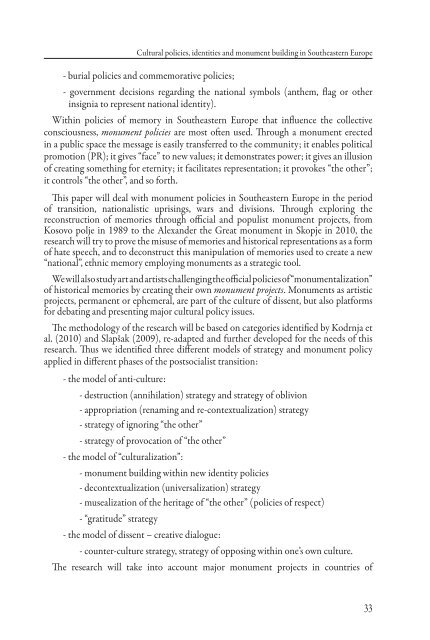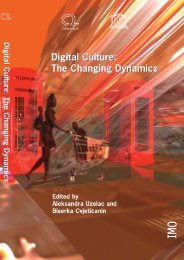free download in pdf format - Culturelink Network
free download in pdf format - Culturelink Network
free download in pdf format - Culturelink Network
Create successful ePaper yourself
Turn your PDF publications into a flip-book with our unique Google optimized e-Paper software.
Cultural policies, identities and monument build<strong>in</strong>g <strong>in</strong> Southeastern Europe<br />
- burial policies and commemorative policies;<br />
- government decisions regard<strong>in</strong>g the national symbols (anthem, fl ag or other<br />
<strong>in</strong>signia to represent national identity).<br />
With<strong>in</strong> policies of memory <strong>in</strong> Southeastern Europe that <strong>in</strong>fl uence the collective<br />
consciousness, monument policies are most oft en used. Th rough a monument erected<br />
<strong>in</strong> a public space the message is easily transferred to the community; it enables political<br />
promotion (PR); it gives “face” to new values; it demonstrates power; it gives an illusion<br />
of creat<strong>in</strong>g someth<strong>in</strong>g for eternity; it facilitates representation; it provokes “the other”;<br />
it controls “the other”, and so forth.<br />
Th is paper will deal with monument policies <strong>in</strong> Southeastern Europe <strong>in</strong> the period<br />
of transition, nationalistic upris<strong>in</strong>gs, wars and divisions. Th rough explor<strong>in</strong>g the<br />
reconstruction of memories through offi cial and populist monument projects, from<br />
Kosovo polje <strong>in</strong> 1989 to the Alexander the Great monument <strong>in</strong> Skopje <strong>in</strong> 2010, the<br />
research will try to prove the misuse of memories and historical representations as a form<br />
of hate speech, and to deconstruct this manipulation of memories used to create a new<br />
“national”, ethnic memory employ<strong>in</strong>g monuments as a strategic tool.<br />
We will also study art and artists challeng<strong>in</strong>g the offi cial policies of “monumentalization”<br />
of historical memories by creat<strong>in</strong>g their own monument projects. Monuments as artistic<br />
projects, permanent or ephemeral, are part of the culture of dissent, but also platforms<br />
for debat<strong>in</strong>g and present<strong>in</strong>g major cultural policy issues.<br />
Th e methodology of the research will be based on categories identifi ed by Kodrnja et<br />
al. (2010) and Slapšak (2009), re-adapted and further developed for the needs of this<br />
research. Th us we identifi ed three diff erent models of strategy and monument policy<br />
applied <strong>in</strong> diff erent phases of the postsocialist transition:<br />
- the model of anti-culture:<br />
- destruction (annihilation) strategy and strategy of oblivion<br />
- appropriation (renam<strong>in</strong>g and re-contextualization) strategy<br />
- strategy of ignor<strong>in</strong>g “the other”<br />
- strategy of provocation of “the other”<br />
- the model of “culturalization”:<br />
- monument build<strong>in</strong>g with<strong>in</strong> new identity policies<br />
- decontextualization (universalization) strategy<br />
- musealization of the heritage of “the other” (policies of respect)<br />
- “gratitude” strategy<br />
- the model of dissent – creative dialogue:<br />
- counter-culture strategy, strategy of oppos<strong>in</strong>g with<strong>in</strong> one’s own culture.<br />
Th e research will take <strong>in</strong>to account major monument projects <strong>in</strong> countries of<br />
33



